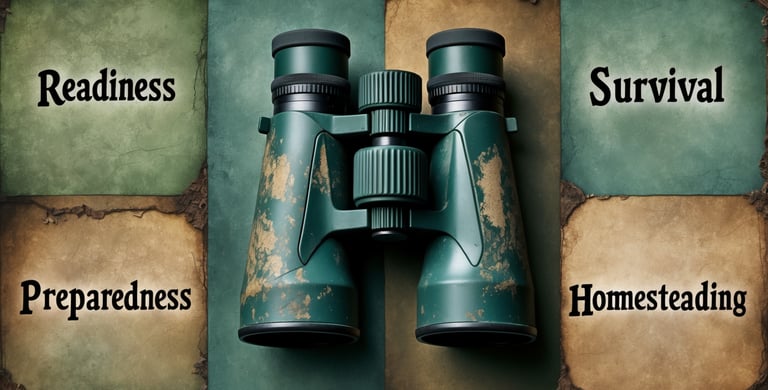Readiness: Redundancy and Risk Management
The Discipline of Layered Security
4FORTITUDER - READINESS, SURVIVAL, PREPAREDNESS, HOMESTEADING
Readiness: Redundancy and Risk Management
The Discipline of Layered Security
"A prudent man foresees the evil, and hides himself; but the simple pass on, and are punished."
— Proverbs 27:12
When One Is None
Every system will fail. The only question is when. In times of peace, redundancy seems wasteful. In times of crisis, it becomes priceless. Readiness demands that a man never trust his survival to a single point of failure. Whether the threat is physical, digital, mechanical, or social—the wise build layers. The simple rely on luck.
In the Taoist classics, it is written: "The stiff and unyielding are the companions of death, the soft and yielding are the companions of life." Redundancy is flexibility applied to logistics. It is strategic humility—the confession that you cannot predict the exact day things will go wrong, but you can refuse to be caught unready.
Core Knowledge Foundation: The Structure of Redundant Readiness
Redundancy is the deliberate duplication of critical systems to prevent total failure. Risk management is the active process of identifying vulnerabilities, calculating potential impact, and implementing layered protections. Together, they form a vital pillar of operational resilience.
A man managing risk is not afraid—he is responsible. He doesn’t just carry one knife, store one water jug, or rely on one income source. He trains with backups, lives with buffers, and leads with contingencies.
Core elements of redundancy:
Triple Redundancy Rule: One is none, two is one, three is stability.
Risk Tiering: Categorize threats by severity and likelihood. Prepare for the catastrophic first.
Diversification: Spread your dependencies—across tools, resources, locations, and people.
Testing and Drills: Your backup isn’t real until you’ve proven it works under stress.
Misconception Warning: Redundancy is not hoarding. It is strategic duplication—each piece purposeful, each layer tested.
Advanced Insights: How Systems Fail and Men Prevail
Systems do not fail all at once—they fail at the weakest node first. Redundancy buys time. Time buys decision-making. Decision-making buys survival.
Historical Anchor: Apollo 13 (1970)
When an oxygen tank exploded in space, the Apollo 13 crew survived not by luck—but by layered systems and emergency drills. NASA had trained redundancies into every phase: multiple oxygen sources, backup computers, alternate re-entry paths. They did not panic—they executed protocols. That is readiness. That is resilience through redundancy.
Real-life implementation means:
Power: Solar, generator, battery bank.
Water: Stored, filtered, collected.
Defense: Tools, training, perimeter protocols.
Communication: Digital, analog, physical meeting plans.
It is not enough to possess gear. You must understand failure points—and buffer each with a fallback.
Practice Drill:
Simulate the failure of your top three systems (e.g., power, water, access to internet). Live for 48 hours as if they are gone. Identify every strain, then fortify those weak links.
Critical Perspectives: The False God of Simplicity
Adversarial Viewpoint: "Minimalism is efficiency. Carrying backups is clutter. Planning for problems attracts them. Focus on mindset—not material crutches."
Response: Minimalism is only virtuous if paired with competence. Simplicity that ignores failure is negligence. Redundancy is not fear-based—it’s wisdom forged in realism. Mindset matters—but tools save lives.
Wisdom and Warning Duality:
When Followed: Your family endures hardship with calm because systems bend without breaking.
When Ignored: Your readiness fails when the first piece of the plan fails—because you treated life like a blueprint, not a battlefield.
Strategic Crossroad: Will you build a system that assumes you’re always right—or one that still protects you when you’re wrong?
Final Charge & Implementation
Brother, you are not weak because you plan for collapse. You are strong because you have accepted its possibility and chosen to act.
Start now:
Conduct a Personal Risk Audit
"Readiness begins where assumption ends." — James Wesley Rawles
List your five most essential systems: food, water, shelter, power, communication. For each, write down what would happen if it failed. Then, write two redundancies for each.Run a Failure Simulation Drill
"Redundancy isn’t tested in thought—it’s proven in friction." — Survivalist Field Manual (paraphrased)
Shut off your power for one night. Try a week without grocery runs. Replace one dependency with a backup—and record the friction.
Strategic Reflection:
What are you relying on right now that, if it failed, would cause immediate crisis? Why haven’t you secured it?
Existential Challenge:
Are you building a fortress—or a fantasy? Because your enemy is not imaginary. And he is counting on your single point of failure.
Let others trust the grid, the government, the algorithm. You—fortify. You—layer. You—train your systems like you train your body: for failure, for chaos, for war.
"Redundancy is the humility of a wise man who refuses to bet his legacy on a perfect world."


